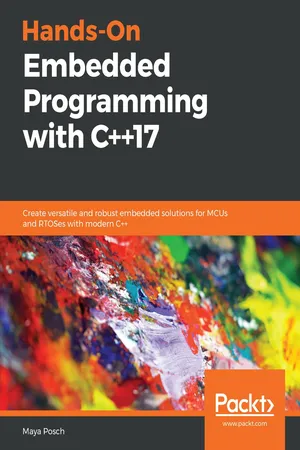
Hands-On Embedded Programming with C++17
Create versatile and robust embedded solutions for MCUs and RTOSes with modern C++
- 458 pages
- English
- ePUB (mobile friendly)
- Available on iOS & Android
Hands-On Embedded Programming with C++17
Create versatile and robust embedded solutions for MCUs and RTOSes with modern C++
About this book
Build safety-critical and memory-safe stand-alone and networked embedded systems
Key Features
- Know how C++ works and compares to other languages used for embedded development
- Create advanced GUIs for embedded devices to design an attractive and functional UI
- Integrate proven strategies into your design for optimum hardware performance
Book Description
C++ is a great choice for embedded development, most notably, because it does not add any bloat, extends maintainability, and offers many advantages over different programming languages. Hands-On Embedded Programming with C++17 will show you how C++ can be used to build robust and concurrent systems that leverage the available hardware resources.
Starting with a primer on embedded programming and the latest features of C++17, the book takes you through various facets of good programming. You'll learn how to use the concurrency, memory management, and functional programming features of C++ to build embedded systems. You will understand how to integrate your systems with external peripherals and efficient ways of working with drivers. This book will also guide you in testing and optimizing code for better performance and implementing useful design patterns. As an additional benefit, you will see how to work with Qt, the popular GUI library used for building embedded systems.
By the end of the book, you will have gained the confidence to use C++ for embedded programming.
What you will learn
- Choose the correct type of embedded platform to use for a project
- Develop drivers for OS-based embedded systems
- Use concurrency and memory management with various microcontroller units (MCUs)
- Debug and test cross-platform code with Linux
- Implement an infotainment system using a Linux-based single board computer
- Extend an existing embedded system with a Qt-based GUI
- Communicate with the FPGA side of a hybrid FPGA/SoC system
Who this book is for
If you want to start developing effective embedded programs in C++, then this book is for you. Good knowledge of C++ language constructs is required to understand the topics covered in the book. No knowledge of embedded systems is assumed.
Frequently asked questions
- Essential is ideal for learners and professionals who enjoy exploring a wide range of subjects. Access the Essential Library with 800,000+ trusted titles and best-sellers across business, personal growth, and the humanities. Includes unlimited reading time and Standard Read Aloud voice.
- Complete: Perfect for advanced learners and researchers needing full, unrestricted access. Unlock 1.4M+ books across hundreds of subjects, including academic and specialized titles. The Complete Plan also includes advanced features like Premium Read Aloud and Research Assistant.
Please note we cannot support devices running on iOS 13 and Android 7 or earlier. Learn more about using the app.
Information
Section 1: The Fundamentals - Embedded programming and the role of C++
- Chapter 1, What Are Embedded Systems?
- Chapter 2, C++ as an Embedded Language
- Chapter 3, Developing for Embedded Linux and Similar Systems
- Chapter 4, Resource-Restricted Embedded Systems
- Chapter 5, Example - Soil Humidity Monitor with Wi-Fi
What Are Embedded Systems?
- Different categories of embedded platforms
- Examples of each category
- Development challenges of each category
The many faces of embedded systems
- Microcontrollers (MCUs)
- System-on-Chip (SoC), often as a Single-Board Computer (SBC)
Microcontrollers
Table of contents
- Title Page
- Copyright and Credits
- About Packt
- Contributors
- Preface
- Section 1: The Fundamentals - Embedded programming and the role of C++
- What Are Embedded Systems?
- C++ as an Embedded Language
- Developing for Embedded Linux and Similar Systems
- Resource-Restricted Embedded Systems
- Example - Soil Humidity Monitor with Wi-Fi
- Section 2: Testing, Monitoring
- Testing OS-Based Applications
- Testing Resource-Restricted Platforms
- Example - Linux-Based Infotainment System
- Example - Building Monitoring and Control
- Section 3: Integration with other tools and frameworks
- Developing Embedded Systems with Qt
- Developing for Hybrid SoC/FPGA Systems
- Best Practices
- Other Books You May Enjoy